Molecular and Epidemiological Analysis of Carbapenem-Resistant Klebsiella pneumoniae in a Greek Tertiary Hospital: A Retrospective Study
Abstract
1. Introduction
2. Materials and Methods
3. Results
3.1. Bacterial Isolates
3.2. Clinical Characteristics of the Patients and Antibiotic Susceptibility of KPC-2 and KPC-9
3.3. Outbreak Description
3.4. Analysis of Mortality Rate in Relation to KPC Allele
4. Discussion
5. Conclusions
Supplementary Materials
Author Contributions
Funding
Institutional Review Board Statement
Informed Consent Statement
Data Availability Statement
Conflicts of Interest
References
- Murray, C.; Ikuta, K.; Sharara, F.; Swetschinski, L.; Aguilar, G.; Gray, A.; Han, C.; Bisignano, C.; Rao, P.; Wool, E. Global Burden of Bacterial Antimicrobial Resistance in 2019: A Systematic Analysis. Lancet 2022, 399, 629–655. [Google Scholar] [CrossRef]
- Caliskan-Aydogan, O.; Alocilja, E.C. A Review of Carbapenem Resistance in Enterobacterales and Its Detection Techniques. Microorganisms 2023, 11, 1491. [Google Scholar] [CrossRef] [PubMed]
- Queenan, A.M.; Bush, K. Carbapenemases: The Versatile Beta-Lactamases. Clin. Microbiol. Rev. 2007, 20, 440–458. [Google Scholar] [CrossRef] [PubMed]
- Ramos-Castañeda, J.A.; Ruano-Ravina, A.; Barbosa-Lorenzo, R.; Paillier-Gonzalez, J.E.; Saldaña-Campos, J.C.; Salinas, D.F.; Lemos-Luengas, E.V. Mortality Due to KPC Carbapenemase-Producing Klebsiella Pneumoniae Infections: Systematic Review and Meta-Analysis: Mortality Due to KPC Klebsiella Pneumoniae Infections. J. Infect. 2018, 76, 438–448. [Google Scholar] [CrossRef]
- Logan, L.K.; Weinstein, R.A. The Epidemiology of Carbapenem-Resistant Enterobacteriaceae: The Impact and Evolution of a Global Menace. J. Infect. Dis. 2017, 215, S28–S36. [Google Scholar] [CrossRef]
- Porreca, A.M.; Sullivan, K.V.; Gallagher, J.C. The Epidemiology, Evolution, and Treatment of KPC-Producing Organisms. Curr. Infect. Dis. Rep. 2018, 20, 13. [Google Scholar] [CrossRef]
- Campos, A.C.; Albiero, J.; Ecker, A.B.; Kuroda, C.M.; Meirelles, L.E.F.; Polato, A.; Tognim, M.C.B.; Wingeter, M.A.; Teixeira, J.J.V. Outbreak of Klebsiella Pneumoniae Carbapenemase-Producing K Pneumoniae: A Systematic Review. Am. J. Infect. Control 2016, 44, 1374–1380. [Google Scholar] [CrossRef]
- Nordmann, P.; Naas, T.; Poirel, L. Global Spread of Carbapenemase-Producing Enterobacteriaceae. Emerg. Infect. Dis. 2011, 17, 1791–1798. [Google Scholar] [CrossRef]
- Girmenia, C.; Serrao, A.; Canichella, M. Epidemiology of Carbapenem Resistant Klebsiella Pneumoniae Infections in Mediterranean Countries. Mediterr. J. Hematol. Infect. Dis. 2016, 8, e2016032. [Google Scholar] [CrossRef]
- Chen, L.F.; Anderson, D.J.; Paterson, D.L. Overview of the Epidemiology and the Threat of Klebsiella Pneumoniae Carbapenemases (KPC) Resistance. Infect. Drug Resist. 2012, 5, 133–141. [Google Scholar] [CrossRef]
- Reference Gene Catalog—Pathogen Detection—NCBI. Available online: https://www.ncbi.nlm.nih.gov/pathogens/refgene/#gene_family:(blaKPC) (accessed on 16 February 2025).
- Lee, C.-R.; Lee, J.H.; Park, K.S.; Kim, Y.B.; Jeong, B.C.; Lee, S.H. Global Dissemination of Carbapenemase-Producing Klebsiella Pneumoniae: Epidemiology, Genetic Context, Treatment Options, and Detection Methods. Front. Microbiol. 2016, 7, 895. [Google Scholar] [CrossRef] [PubMed]
- Hammoudi Halat, D.; Ayoub Moubareck, C. The Current Burden of Carbapenemases: Review of Significant Properties and Dissemination among Gram-Negative Bacteria. Antibiotics 2020, 9, 186. [Google Scholar] [CrossRef] [PubMed]
- Alvisi, G.; Curtoni, A.; Fonnesu, R.; Piazza, A.; Signoretto, C.; Piccinini, G.; Sassera, D.; Gaibani, P. Epidemiology and Genetic Traits of Carbapenemase-Producing Enterobacterales: A Global Threat to Human Health. Antibiotics 2025, 14, 141. [Google Scholar] [CrossRef] [PubMed]
- Gartzonika, K.; Rossen, J.W.A.; Sakkas, H.; Rosema, S.; Priavali, E.; Friedrich, A.W.; Levidiotou, S.; Bathoorn, E. Identification of a KPC-9-Producing Klebsiella Pneumoniae ST258 Cluster among KPC-2-Producing Isolates of an Ongoing Outbreak in Northwestern Greece: A Retrospective Study. Clin. Microbiol. Infect. 2018, 24, 558–560. [Google Scholar] [CrossRef]
- Hidalgo-Grass, C.; Warburg, G.; Temper, V.; Benenson, S.; Moses, A.E.; Block, C.; Strahilevitz, J. KPC-9, a Novel Carbapenemase from Clinical Specimens in Israel. Antimicrob. Agents Chemother. 2012, 56, 6057–6059. [Google Scholar] [CrossRef]
- CLSI. Performance Standards for Antimicrobial Susceptibility Testing, 34th ed.; CLSI Supplement M100; Clinical and Laboratory Standards Institute: Malvern, PA, USA, 2024. [Google Scholar]
- Girlich, D.; Poirel, L.; Nordmann, P. Value of the Modified Hodge Test for Detection of Emerging Carbapenemases in Enterobacteriaceae. J. Clin. Microbiol. 2012, 50, 477–479. [Google Scholar] [CrossRef]
- Tsakris, A.; Poulou, A.; Pournaras, S.; Voulgari, E.; Vrioni, G.; Themeli-Digalaki, K.; Petropoulou, D.; Sofianou, D. A Simple Phenotypic Method for the Differentiation of Metallo-Beta-Lactamases and Class A KPC Carbapenemases in Enterobacteriaceae Clinical Isolates. J. Antimicrob. Chemother. 2010, 65, 1664–1671. [Google Scholar] [CrossRef]
- Tigecycline—Injection Products. FDA-Identified Interpretive Criteria. Available online: https://www.fda.gov/drugs/development-resources/tigecycline-injection-products (accessed on 15 December 2024).
- The European Committee on Antimicrobial Susceptibility Testing. Breakpoint Tables for Interpretation of MICs and Zone Diameters v.14.0. 2024. Available online: https://www.eucast.org/fileadmin/src/media/PDFs/EUCAST_files/Breakpoint_tables/v_14.0_Breakpoint_Tables.pdf (accessed on 15 December 2024).
- Magiorakos, A.-P.; Srinivasan, A.; Carey, R.B.; Carmeli, Y.; Falagas, M.E.; Giske, C.G.; Harbarth, S.; Hindler, J.F.; Kahlmeter, G.; Olsson-Liljequist, B.; et al. Multidrug-Resistant, Extensively Drug-Resistant and Pandrug-Resistant Bacteria: An International Expert Proposal for Interim Standard Definitions for Acquired Resistance. Clin. Microbiol. Infect. 2012, 18, 268–281. [Google Scholar] [CrossRef]
- Poulou, A.; Grivakou, E.; Vrioni, G.; Koumaki, V.; Pittaras, T.; Pournaras, S.; Tsakris, A. Modified CLSI Extended-Spectrum β-Lactamase (ESBL) Confirmatory Test for Phenotypic Detection of ESBLs among Enterobacteriaceae Producing Various β-Lactamases. J. Clin. Microbiol. 2014, 52, 1483–1489. [Google Scholar] [CrossRef]
- Dashti, A.A.; Jadaaon, M.M.; Abdulsamad, A.M.; Dashti, H.M. Heat Treatment of Bacteria: A Simple Method of DNA Extraction for Molecular Techniques. Kuwait Med. J. 2009, 41, 117–122. [Google Scholar]
- Lomaestro, B.M.; Tobin, E.H.; Shang, W.; Gootz, T. The Spread of Klebsiella Pneumoniae Carbapenemase–Producing K. Pneumoniae to Upstate New York. Clin. Infect. Dis. 2006, 43, e26–e28. [Google Scholar] [CrossRef] [PubMed][Green Version]
- Poirel, L.; Naas, T.; Nicolas, D.; Collet, L.; Bellais, S.; Cavallo, J.D.; Nordmann, P. Characterization of VIM-2, a Carbapenem-Hydrolyzing Metallo-Beta-Lactamase and Its Plasmid- and Integron-Borne Gene from a Pseudomonas Aeruginosa Clinical Isolate in France. Antimicrob. Agents Chemother. 2000, 44, 891–897. [Google Scholar] [CrossRef]
- Manchanda, V.; Rai, S.; Gupta, S.; Rautela, R.S.; Chopra, R.; Rawat, D.S.; Verma, N.; Singh, N.P.; Kaur, I.R.; Bhalla, P. Development of TaqMan Real-Time Polymerase Chain Reaction for the Detection of the Newly Emerging Form of Carbapenem Resistance Gene in Clinical Isolates of Escherichia Coli, Klebsiella Pneumoniae, and Acinetobacter Baumannii. Indian J. Med. Microbiol. 2011, 29, 249–253. [Google Scholar] [CrossRef] [PubMed]
- Tzelepi, E.; Magana, C.; Platsouka, E.; Sofianou, D.; Paniara, O.; Legakis, N.J.; Vatopoulos, A.C.; Tzouvelekis, L.S. Extended-Spectrum Beta-Lactamase Types in Klebsiella Pneumoniae and Escherichia Coli in Two Greek Hospitals. Int. J. Antimicrob. Agents 2003, 21, 285–288. [Google Scholar] [CrossRef] [PubMed]
- Gartzonika, K.; Bozidis, P.; Priavali, E.; Sakkas, H. Rapid Detection of blaKPC-9 Allele from Clinical Isolates. Pathogens 2021, 10, 487. [Google Scholar] [CrossRef]
- Institut Pasteur MLST Databases and Software. Available online: https://bigsdb.pasteur.fr/klebsiella/primers-used/ (accessed on 16 February 2025).
- Hansen, G.T. Continuous Evolution: Perspective on the Epidemiology of Carbapenemase Resistance Among Enterobacterales and Other Gram-Negative Bacteria. Infect. Dis. Ther. 2021, 10, 75–92. [Google Scholar] [CrossRef]
- Tryfinopoulou, K.; Linkevicius, M.; Pappa, O.; Alm, E.; Karadimas, K.; Svartström, O.; Polemis, M.; Mellou, K.; Maragkos, A.; Brolund, A.; et al. Emergence and Persistent Spread of Carbapenemase-Producing Klebsiella Pneumoniae High-Risk Clones in Greek Hospitals, 2013 to 2022. Eurosurveillance 2023, 28, 2300571. [Google Scholar] [CrossRef]
- Cantón, R.; González-Alba, J.M.; Galán, J.C. CTX-M Enzymes: Origin and Diffusion. Front. Microbiol. 2012, 3, 110. [Google Scholar] [CrossRef]
- Gales, A.C.; Stone, G.; Sahm, D.F.; Wise, M.G.; Utt, E. Incidence of ESBLs and Carbapenemases among Enterobacterales and Carbapenemases in Pseudomonas Aeruginosa Isolates Collected Globally: Results from ATLAS 2017-2019. J. Antimicrob. Chemother. 2023, 78, 1606–1615. [Google Scholar] [CrossRef]
- Kazmierczak, K.M.; de Jonge, B.L.M.; Stone, G.G.; Sahm, D.F. Longitudinal Analysis of ESBL and Carbapenemase Carriage among Enterobacterales and Pseudomonas Aeruginosa Isolates Collected in Europe as Part of the International Network for Optimal Resistance Monitoring (INFORM) Global Surveillance Programme, 2013–2017. J. Antimicrob. Chemother. 2020, 75, 1165–1173. [Google Scholar] [CrossRef]
- Galani, I.; Karaiskos, I.; Karantani, I.; Papoutsaki, V.; Maraki, S.; Papaioannou, V.; Kazila, P.; Tsorlini, H.; Charalampaki, N.; Toutouza, M.; et al. Epidemiology and Resistance Phenotypes of Carbapenemase-Producing Klebsiella Pneumoniae in Greece, 2014 to 2016. Eurosurveillance 2018, 23, 1700775. [Google Scholar] [CrossRef] [PubMed]
- Bathoorn, E.; Tsioutis, C.; da Silva Voorham, J.M.; Scoulica, E.V.; Ioannidou, E.; Zhou, K.; Rossen, J.W.; Gikas, A.; Friedrich, A.W.; Grundmann, H. Emergence of Pan-Resistance in KPC-2 Carbapenemase-Producing Klebsiella Pneumoniae in Crete, Greece: A Close Call. J. Antimicrob. Chemother. 2016, 71, 1207–1212. [Google Scholar] [CrossRef] [PubMed]
- Galani, I.; Nafplioti, K.; Adamou, P.; Karaiskos, I.; Giamarellou, H.; Souli, M. Study Collaborators Nationwide Epidemiology of Carbapenem Resistant Klebsiella Pneumoniae Isolates from Greek Hospitals, with Regards to Plazomicin and Aminoglycoside Resistance. BMC Infect. Dis. 2019, 19, 167. [Google Scholar] [CrossRef]
- Antimicrobial Resistance in the EU/EEA (EARS-Net)—Annual Epidemiological Report for 2019. Country Summaries-AER-EARS. Available online: https://www.ecdc.europa.eu/sites/default/files/documents/Country%20summaries-AER-EARS-Net%20202019.pdf (accessed on 16 February 2025).
- Country Summaries—Antimicrobial Resistance in the EU/EEA. 2023. Available online: https://www.ecdc.europa.eu/sites/default/files/documents/Country_profiles_2023_2024_1.pdf (accessed on 16 February 2025).
- Zhan, Q.; Xu, Y.; Wang, B.; Yu, J.; Shen, X.; Liu, L.; Cao, X.; Guo, Y.; Yu, F. Distribution of Fluoroquinolone Resistance Determinants in Carbapenem-Resistant Klebsiella Pneumoniae Clinical Isolates Associated with Bloodstream Infections in China. BMC Microbiol. 2021, 21, 164. [Google Scholar] [CrossRef]
- Oueslati, S.; Iorga, B.I.; Tlili, L.; Exilie, C.; Zavala, A.; Dortet, L.; Jousset, A.B.; Bernabeu, S.; Bonnin, R.A.; Naas, T. Unravelling Ceftazidime/Avibactam Resistance of KPC-28, a KPC-2 Variant Lacking Carbapenemase Activity. J. Antimicrob. Chemother. 2019, 74, 2239–2246. [Google Scholar] [CrossRef]
- Mehta, S.C.; Rice, K.; Palzkill, T. Natural Variants of the KPC-2 Carbapenemase Have Evolved Increased Catalytic Efficiency for Ceftazidime Hydrolysis at the Cost of Enzyme Stability. PLoS Pathog. 2015, 11, e1004949. [Google Scholar] [CrossRef]
- Parwana, D.; Gu, J.; Chen, S.; Bethel, C.R.; Marshall, E.; Hujer, A.M.; Bonomo, R.A.; Haider, S. The Structural Role of N170 in Substrate-Assisted Deacylation in KPC-2 β-Lactamase. Angew. Chem. Int. Ed. 2024, 63, e202317315. [Google Scholar] [CrossRef]
- Sun, Z.; Lin, H.; Hu, L.; Neetu, N.; Sankaran, B.; Wang, J.; Prasad, B.V.V.; Palzkill, T. Klebsiella Pneumoniae Carbapenemase Variant 44 Acquires Ceftazidime-Avibactam Resistance by Altering the Conformation of Active-Site Loops. J. Biol. Chem. 2024, 300, 105493. [Google Scholar] [CrossRef]
- Wu, Y.; Yang, X.; Liu, C.; Zhang, Y.; Cheung, Y.C.; Wai Chi Chan, E.; Chen, S.; Zhang, R. Identification of a KPC Variant Conferring Resistance to Ceftazidime-Avibactam from ST11 Carbapenem-Resistant Klebsiella Pneumoniae Strains. Microbiol. Spectr. 2022, 10, e02655-21. [Google Scholar] [CrossRef]
- Hobson, C.A.; Pierrat, G.; Tenaillon, O.; Bonacorsi, S.; Bercot, B.; Jaouen, E.; Jacquier, H.; Birgy, A. Klebsiella Pneumoniae Carbapenemase Variants Resistant to Ceftazidime-Avibactam: An Evolutionary Overview. Antimicrob. Agents Chemother. 2022, 66, e00447-22. [Google Scholar] [CrossRef]
- Yoon, E.-J.; Choi, Y.J.; Park, S.H.; Shin, J.H.; Park, S.G.; Choi, J.R.; Jeong, S.H. A Novel KPC Variant KPC-55 in Klebsiella Pneumoniae ST307 of Reinforced Meropenem-Hydrolyzing Activity. Front. Microbiol. 2020, 11, 561317. [Google Scholar] [CrossRef] [PubMed]
- Almaghrabi, R.; Clancy, C.J.; Doi, Y.; Hao, B.; Chen, L.; Shields, R.K.; Press, E.G.; Iovine, N.M.; Townsend, B.M.; Wagener, M.M.; et al. Carbapenem-Resistant Klebsiella Pneumoniae Strains Exhibit Diversity in Aminoglycoside-Modifying Enzymes, Which Exert Differing Effects on Plazomicin and Other Agents. Antimicrob. Agents Chemother. 2014, 58, 4443–4451. [Google Scholar] [CrossRef] [PubMed]
- Deleo, F.R.; Chen, L.; Porcella, S.F.; Martens, C.A.; Kobayashi, S.D.; Porter, A.R.; Chavda, K.D.; Jacobs, M.R.; Mathema, B.; Olsen, R.J.; et al. Molecular Dissection of the Evolution of Carbapenem-Resistant Multilocus Sequence Type 258 Klebsiella Pneumoniae. Proc. Natl. Acad. Sci. USA 2014, 111, 4988–4993. [Google Scholar] [CrossRef]
- Zhang, F.; Li, Q.; Bai, J.; Ding, M.; Yan, X.; Wang, G.; Zhu, B.; Zhou, Y. Heteroresistance to Amikacin in Carbapenem-Resistant Klebsiella Pneumoniae Strains. Front. Microbiol. 2021, 12, 682239. [Google Scholar] [CrossRef] [PubMed]
- Braspenning, A.J.M.M.; Rajakani, S.G.; Sey, A.; El Bounja, M.; Lammens, C.; Glupczynski, Y.; Malhotra-Kumar, S. Assessment of Colistin Heteroresistance among Multidrug-Resistant Klebsiella Pneumoniae Isolated from Intensive Care Patients in Europe. Antibiotics 2024, 13, 281. [Google Scholar] [CrossRef]
- Tumbarello, M.; Trecarichi, E.M.; De Rosa, F.G.; Giannella, M.; Giacobbe, D.R.; Bassetti, M.; Losito, A.R.; Bartoletti, M.; Del Bono, V.; Corcione, S.; et al. Infections Caused by KPC-Producing Klebsiella Pneumoniae: Differences in Therapy and Mortality in a Multicentre Study. J. Antimicrob. Chemother. 2015, 70, 2133–2143. [Google Scholar] [CrossRef]
- Jeffrey, M.; Denny, K.J.; Lipman, J.; Conway Morris, A. Differentiating Infection, Colonisation, and Sterile Inflammation in Critical Illness: The Emerging Role of Host-Response Profiling. Intensive Care Med. 2023, 49, 760–771. [Google Scholar] [CrossRef]
- Xu, L.; Sun, X.; Ma, X. Systematic Review and Meta-Analysis of Mortality of Patients Infected with Carbapenem-Resistant Klebsiella Pneumoniae. Ann. Clin. Microbiol. Antimicrob. 2017, 16, 18. [Google Scholar] [CrossRef]
- Soares de Moraes, L.; Gomes Magalhaes, G.L.; Material Soncini, J.G.; Pelisson, M.; Eches Perugini, M.R.; Vespero, E.C. High Mortality from Carbapenem-Resistant Klebsiella Pneumoniae Bloodstream Infection. Microb. Pathog. 2022, 167, 105519. [Google Scholar] [CrossRef]
- Zarkotou, O.; Pournaras, S.; Tselioti, P.; Dragoumanos, V.; Pitiriga, V.; Ranellou, K.; Prekates, A.; Themeli-Digalaki, K.; Tsakris, A. Predictors of Mortality in Patients with Bloodstream Infections Caused by KPC-Producing Klebsiella Pneumoniae and Impact of Appropriate Antimicrobial Treatment. Clin. Microbiol. Infect. 2011, 17, 1798–1803. [Google Scholar] [CrossRef]
- Zhao, H.; Liu, M.; Wu, J.; Chen, S.; Yang, H.; Long, J.; Duan, G. Mortality and Genetic Diversity of Antibiotic-Resistant Bacteria Associated with Bloodstream Infections: A Systemic Review and Genomic Analysis. BMC Infect. Dis. 2024, 24, 1385. [Google Scholar] [CrossRef]
- Shankar, C.; Karunasree, S.; Manesh, A.; Veeraraghavan, B. First Report of Whole-Genome Sequence of Colistin-Resistant Klebsiella quasipneumoniae subsp. Similipneumoniae Producing KPC-9 in India. Microb. Drug Resist. 2019, 25, 489–493. [Google Scholar] [CrossRef] [PubMed]
- Piccirilli, A.; Cherubini, S.; Azzini, A.M.; Tacconelli, E.; Lo Cascio, G.; Maccacaro, L.; Bazaj, A.; Naso, L.; Amicosante, G.; LTCF-Veneto Working Group; et al. Whole-Genome Sequencing (WGS) of Carbapenem-Resistant K. Pneumoniae Isolated in Long-Term Care Facilities in the Northern Italian Region. Microorganisms 2021, 9, 1985. [Google Scholar] [CrossRef] [PubMed]
- Liao, Q.; Yuan, Y.; Li, Q.; Wu, S.; Liu, Y.; Zhang, W.; Xiao, Y.; Kang, M. Comparing Three Different Phenotypic Methods for Accurate Detection of Carbapenemase-Producing Enterobacterales. J. Infect. Chemother. 2021, 27, 794–799. [Google Scholar] [CrossRef]
- Magiorakos, A.P.; Burns, K.; Rodríguez Baño, J.; Borg, M.; Daikos, G.; Dumpis, U.; Lucet, J.C.; Moro, M.L.; Tacconelli, E.; Simonsen, G.S.; et al. Infection Prevention and Control Measures and Tools for the Prevention of Entry of Carbapenem-Resistant Enterobacteriaceae into Healthcare Settings: Guidance from the European Centre for Disease Prevention and Control. Antimicrob. Resist. Infect. Control 2017, 6, 113. [Google Scholar] [CrossRef]
- CDC. Core Elements of Hospital Antibiotic Stewardship Programs; CDC: Atlanta, GA, USA, 2019. [Google Scholar]
- Partridge, S.R.; Kwong, S.M.; Firth, N.; Jensen, S.O. Mobile Genetic Elements Associated with Antimicrobial Resistance. Clin. Microbiol. Rev. 2018, 31, e00088-17. [Google Scholar] [CrossRef]
- Ding, L.; Shen, S.; Chen, J.; Tian, Z.; Shi, Q.; Han, R.; Guo, Y.; Hu, F. Klebsiella pneumoniae Carbapenemase Variants: The New Threat to Global Public Health. Clin. Microbiol. Rev. 2023, 36, e00008-23. [Google Scholar] [CrossRef]
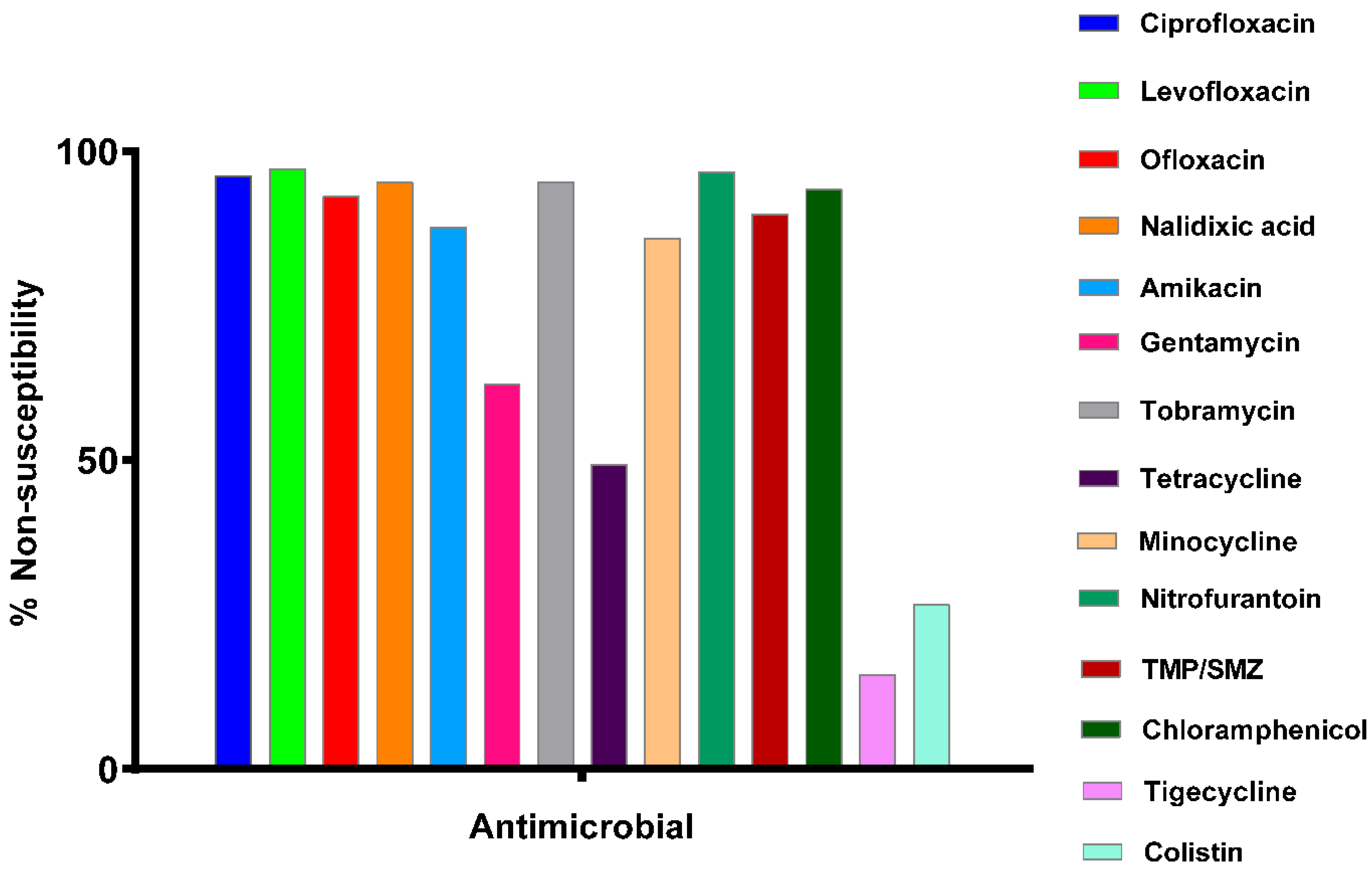
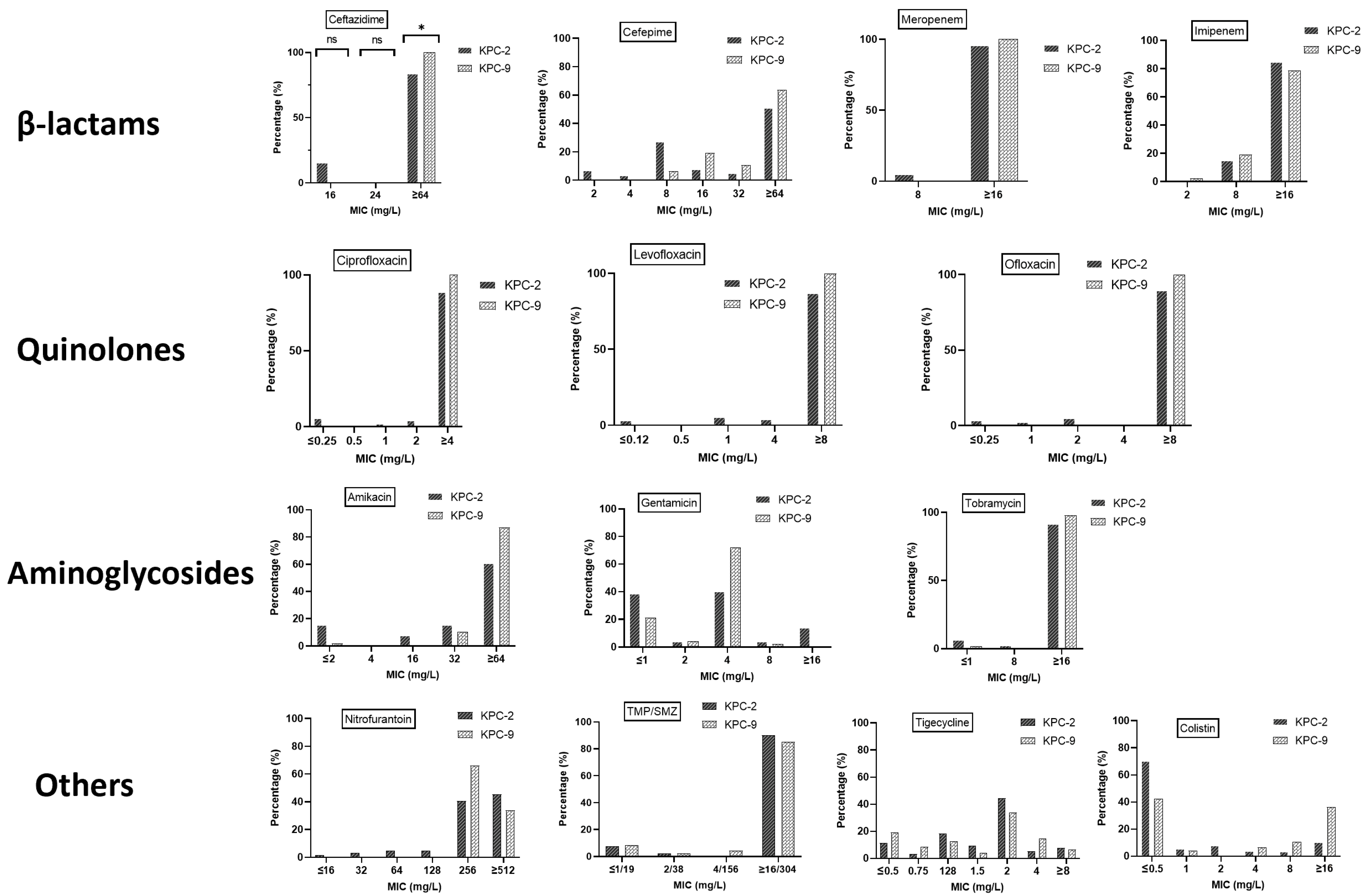
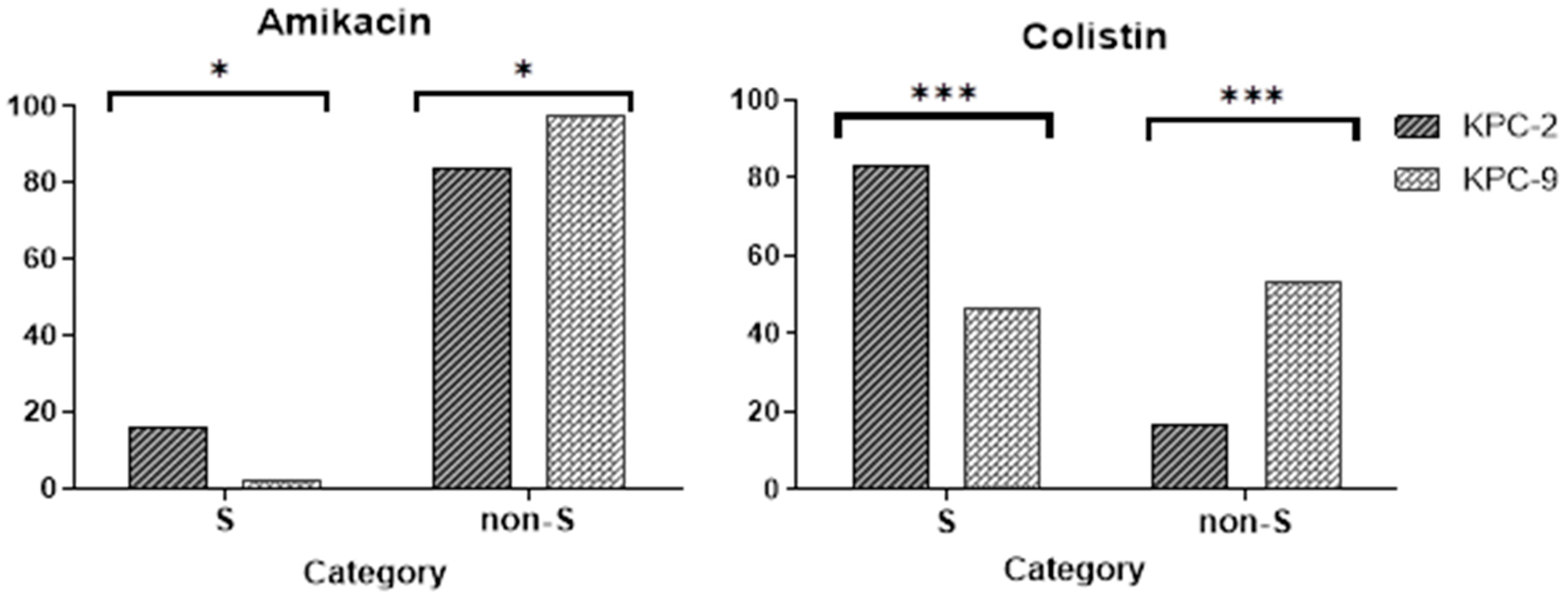
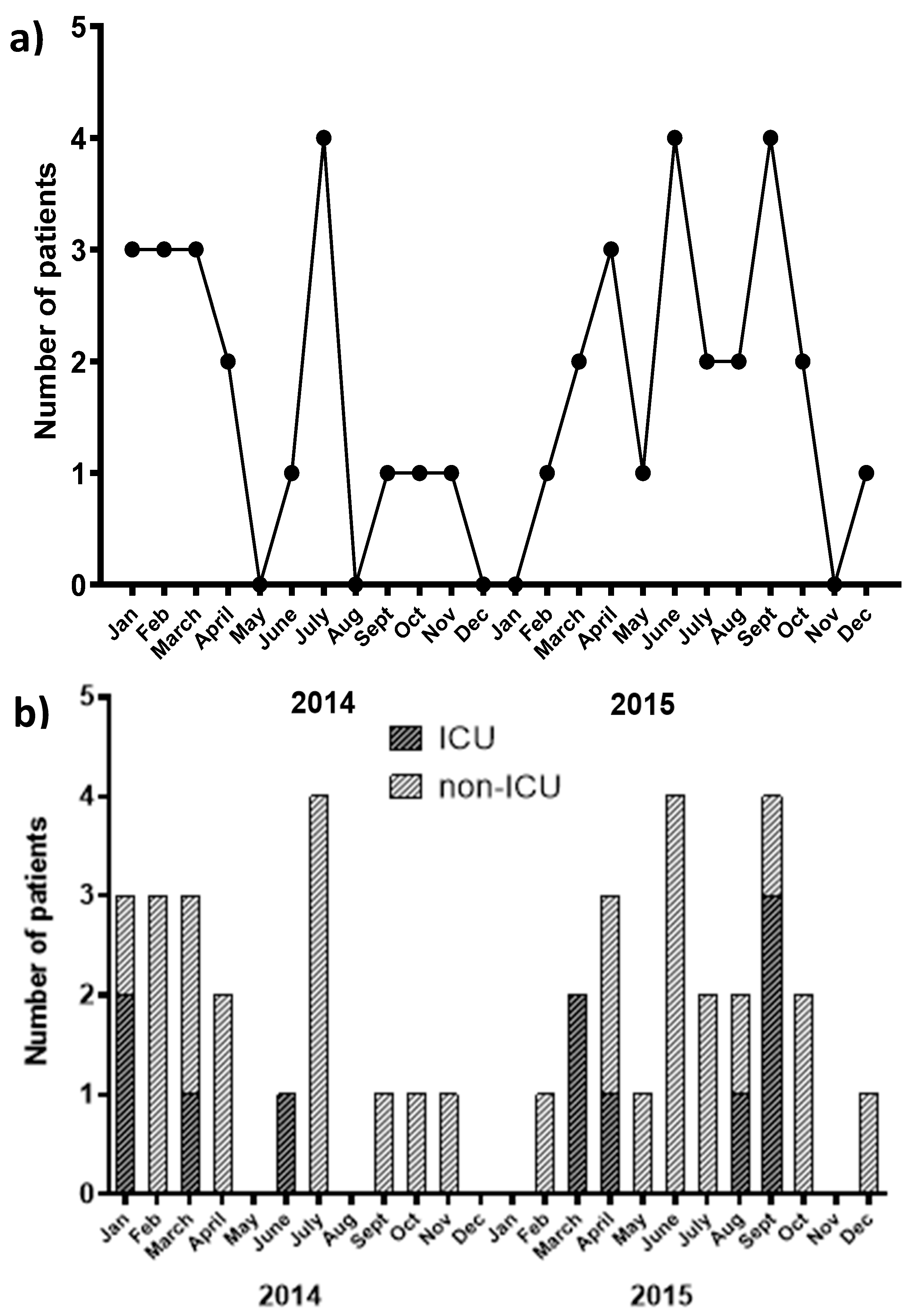
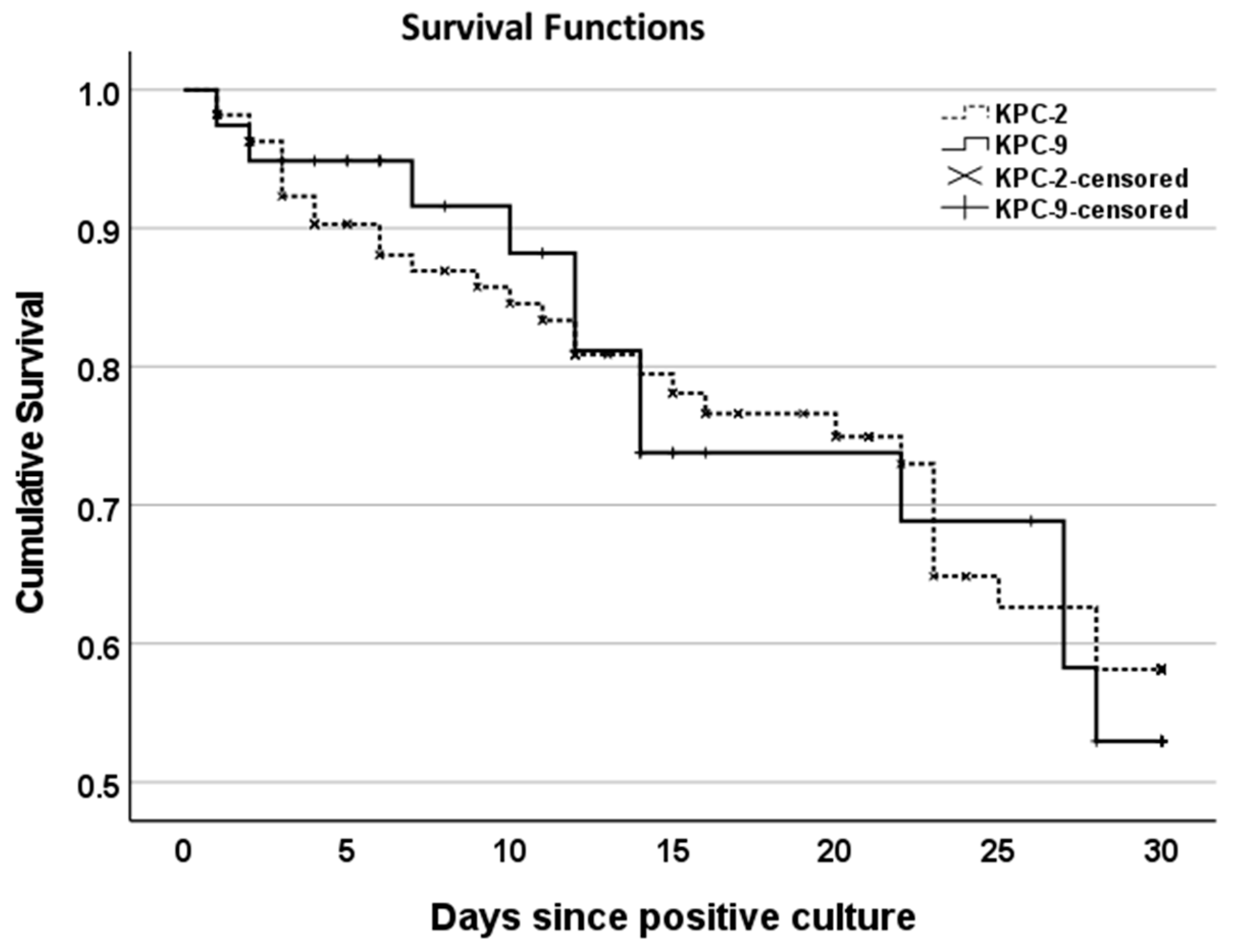
| Genes | KPC-2 | ||
|---|---|---|---|
| N (n%) | KPC-9 | ||
| N (n%) | Total n (%) | ||
| blaNDM | 1 (0.8) | 0 | 1 (0.6) |
| blaVIM | 0 | 0 | 0 |
| blaCTX-M group 1 | 18 (13.8) | 1 (2.1) | 19 (10.7) |
| blaTEM | 96 (73.8) | 44 (93.6) | 140 (79.1) |
| blaSHV | 49 (37.7) | 1 (2.1) | 50 (28.2) |
| blaCTX-M group 1 + blaTEM | 17 (13.1) | 1 (2.1) | 18 (10.2) |
| blaCTX-M group 1 + blaSHV | 5 (3.8) | 0 | 5 (2.8) |
| blaTEM + blaSHV | 29 (22.3) | 0 | 29 (16.4) |
| blaCTX-M group 1 + blaTEM + blaSHV | 4 (3.1) | 0 | 4 (1.7) |
| All (N, %) | KPC-2 (N, %) | KPC-9 (N, %) | ||
|---|---|---|---|---|
| Age (years, average± SD a) | 65 ± 17 | 65 ± 15 | 64 ± 21 | |
| Sex | Male | 83 (55.7) | 61 (56.0) | 22 (55.0) |
| Female | 66 (44.3) | 48 (44.0) | 18 (45.0) | |
| Total | 149 (100) | 109 (100) | 40 (100) | |
| LOS > 2b | 107 (71.8) | 78 (71.6) | 29 (72.5) | |
| Outcome | Discharge | 91 (61.1) | 66 (61.1) | 25 (61.0) |
| Death | 58 (39.9) | 42 (39.9) | 16 (39.0) | |
| Co-morbidities | ||||
| Without medical history | 49 (32.9) | 35 (32.1) | 14 (35.0) | |
| Diabetes mellitus | 10 (6.7) | 6 (5.5) | 4 (10.0) | |
| Hypertension | 10 (6.7) | 7 (6.4) | 3 (7.5) | |
| Coronary heart disease | 22 (14.8) | 21 (19.3) | 1 (2.5) | |
| Chronic obstructive pulmonary disease | 7 (4.7) | 5 (4.6) | 2 (5.0) | |
| Neurological disorders | 30 (20.1) | 21 (19.3) | 9 (22.5) | |
| Kidney/urinary system disorders | 8 (5.4) | 7 (6.4) | 1 (2.5) | |
| Hematologic disease/malignancy | 12 (8.0) | 5 (4.6) | 7 (17.5) | |
| Cancer | 15 (10.0) | 12 (11.0) | 3 (7.5) | |
| Other c | 10 (6.7) | 6 (5.5) | 4 (10.0) | |
| Hospital transfer (all wards) | 88 (59.1) | 68 (62.4) | 20 (50.0) | |
| Transfer to ICUs d | 58 (38.9) | 45 (41.3) | 13 (32.5) | |
Disclaimer/Publisher’s Note: The statements, opinions and data contained in all publications are solely those of the individual author(s) and contributor(s) and not of MDPI and/or the editor(s). MDPI and/or the editor(s) disclaim responsibility for any injury to people or property resulting from any ideas, methods, instructions or products referred to in the content. |
© 2025 by the authors. Licensee MDPI, Basel, Switzerland. This article is an open access article distributed under the terms and conditions of the Creative Commons Attribution (CC BY) license (https://creativecommons.org/licenses/by/4.0/).
Share and Cite
Myari, A.; Bozidis, P.; Priavali, E.; Kapsali, E.; Koulouras, V.; Vrioni, G.; Gartzonika, K. Molecular and Epidemiological Analysis of Carbapenem-Resistant Klebsiella pneumoniae in a Greek Tertiary Hospital: A Retrospective Study. Microbiol. Res. 2025, 16, 81. https://doi.org/10.3390/microbiolres16040081
Myari A, Bozidis P, Priavali E, Kapsali E, Koulouras V, Vrioni G, Gartzonika K. Molecular and Epidemiological Analysis of Carbapenem-Resistant Klebsiella pneumoniae in a Greek Tertiary Hospital: A Retrospective Study. Microbiology Research. 2025; 16(4):81. https://doi.org/10.3390/microbiolres16040081
Chicago/Turabian StyleMyari, Alexandra, Petros Bozidis, Efthalia Priavali, Eleni Kapsali, Vasilios Koulouras, Georgia Vrioni, and Konstantina Gartzonika. 2025. "Molecular and Epidemiological Analysis of Carbapenem-Resistant Klebsiella pneumoniae in a Greek Tertiary Hospital: A Retrospective Study" Microbiology Research 16, no. 4: 81. https://doi.org/10.3390/microbiolres16040081
APA StyleMyari, A., Bozidis, P., Priavali, E., Kapsali, E., Koulouras, V., Vrioni, G., & Gartzonika, K. (2025). Molecular and Epidemiological Analysis of Carbapenem-Resistant Klebsiella pneumoniae in a Greek Tertiary Hospital: A Retrospective Study. Microbiology Research, 16(4), 81. https://doi.org/10.3390/microbiolres16040081







